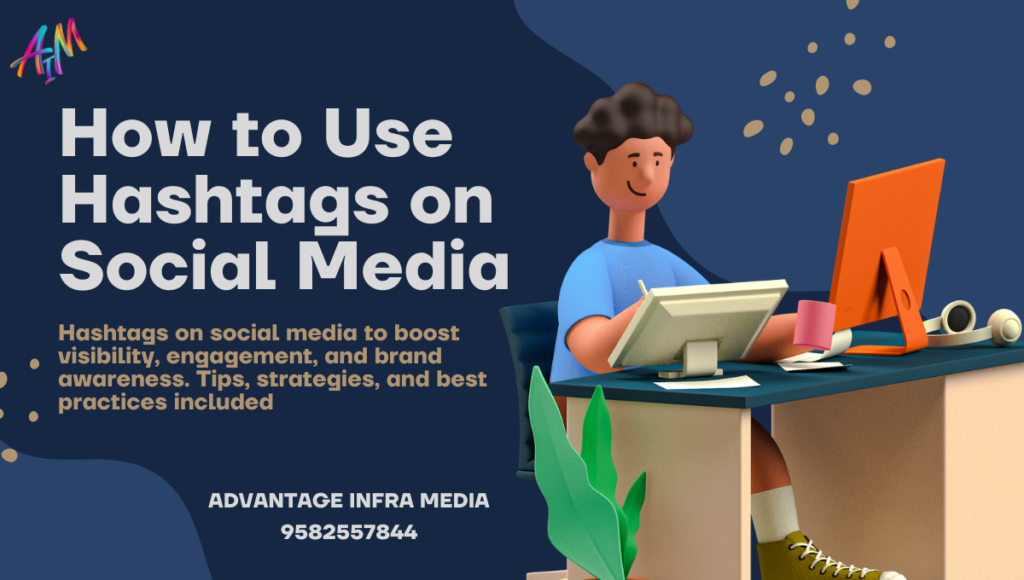Introduction
Hashtags on Social Media have become an integral part of social media culture, transforming from a simple pound sign to a powerful tool for categorizing content, enhancing visibility, and driving engagement. Understanding how to use hashtags effectively can significantly impact your social media strategy, enabling you to reach a broader audience and connect with like-minded individuals or potential customers. This guide will delve into the intricacies of hashtag usage, providing actionable tips and strategies for mastering hashtags across various platforms. (Hashtags on Social Media)
1. The Importance of Hashtags in Social Media Marketing
1.1 Enhancing Discoverability Hashtags act as a categorization tool, allowing your content to be discovered by users who are interested in specific topics. When you use a hashtag, your post is grouped with other posts that include the same hashtag, making it easier for users to find content relevant to their interests. This is particularly useful on platforms like Instagram and Twitter, where hashtags are a primary means of content discovery.
1.2 Boosting Engagement Research shows that posts with hashtags receive higher engagement rates compared to those without. Hashtags make your content more discoverable, leading to increased likes, comments, and shares. By participating in trending hashtags or creating your own, you can tap into larger conversations and reach audiences beyond your existing followers. (Hashtags on Social Media)
1.3 Building Brand Awareness Hashtags can be a powerful branding tool. Branded hashtags, which are unique to your business, help build brand recognition and foster a community around your brand. Encouraging your audience to use your branded hashtag increases user-generated content, further promoting your brand.
2. Understanding Different Types of Hashtags
2.1 Branded Hashtags Branded hashtags are unique to your brand or campaign. They could be your company name, slogan, or a specific campaign tagline. Branded hashtags help you track conversations about your brand and encourage user-generated content.
Examples:
- #JustDoIt (Nike)
- #ShareACoke (Coca-Cola)
2.2 Industry-Specific Hashtags Industry-specific hashtags are used to connect with others in your field and to share industry-related content. These hashtags help you reach a targeted audience who are interested in your niche. (Hashtags on Social Media)
Examples:
- #DigitalMarketing
- #FoodPhotography
2.3 Trending Hashtags Trending hashtags are those that are currently popular and widely used across social media platforms. Participating in trending hashtags can increase your visibility, but it’s essential to ensure that your content is relevant to the hashtag.
Examples:
- #WorldEnvironmentDay
- #Oscars2024
2.4 Content Hashtags Content hashtags are used to describe the content of your post. These are more general and help categorize your content for users searching for that specific topic.
Examples:
- #TravelTips
- #HealthyRecipes
2.5 Location-Based Hashtags Location-based hashtags help you connect with a local audience or highlight the location where your content was created. These are particularly useful for businesses with a physical presence or for travel-related content. (Hashtags on Social Media)
Examples:
- #NewYorkCity
- #ParisTravel
2.6 Campaign Hashtags Campaign hashtags are created for specific marketing campaigns. They are short-lived and focused on a particular promotion or event. These hashtags help track the success of your campaign and encourage audience participation.
Examples:
- #12DaysOfChristmas
- #BackToSchoolSale
3. How to Research and Choose the Right Hashtags
3.1 Analyzing Competitors One of the easiest ways to identify effective hashtags is by analyzing your competitors. Look at the hashtags they use in their successful posts and consider incorporating similar ones into your strategy. However, ensure that the hashtags align with your brand and content. (Hashtags on Social Media)
3.2 Using Hashtag Tools Several tools can help you discover popular and relevant hashtags. Tools like Hashtagify, RiteTag, and Hootsuite allow you to search for hashtags related to your industry and analyze their popularity and engagement levels.
3.3 Balancing Popular and Niche Hashtags While popular hashtags can increase visibility, they also come with high competition. On the other hand, niche hashtags may have a smaller audience but are more targeted. A balanced mix of both can help you reach a broader audience while also connecting with your target market.
3.4 Monitoring Hashtag Performance Once you’ve selected your hashtags, it’s crucial to monitor their performance. Use social media analytics tools to track which hashtags are driving the most engagement and adjust your strategy accordingly. (Hashtags on Social Media)
4. Platform-Specific Hashtag Strategies
4.1 Instagram Instagram allows up to 30 hashtags per post, but it’s not always necessary to use the maximum. Research shows that 9-11 hashtags per post yield the best engagement. Instagram’s Explore page is heavily influenced by hashtags, making them crucial for discoverability.
- Tip: Use a mix of popular, niche, and branded hashtags. Consider placing hashtags in the first comment to keep your caption clean.
4.2 Twitter Twitter’s character limit restricts the number of hashtags you can use. It’s best to stick to 1-2 relevant hashtags per tweet. Hashtags on Twitter can significantly increase engagement, especially when participating in trending topics. (Hashtags on Social Media)
- Tip: Create a branded hashtag for Twitter chats or events to foster real-time conversations.
4.3 Facebook Hashtags are less common on Facebook, and overusing them can appear spammy. However, using 1-2 well-chosen hashtags can still help categorize your content and make it discoverable.
- Tip: Use hashtags sparingly and ensure they are highly relevant to your content.
4.4 LinkedIn Hashtags on LinkedIn help categorize your content and make it discoverable by professionals interested in your industry. It’s advisable to use 3-5 hashtags per post. (Hashtags on Social Media)
- Tip: Focus on industry-specific hashtags to reach a professional audience.
4.5 TikTok Hashtags are crucial on TikTok for getting your content on the “For You” page. While TikTok allows many hashtags, it’s essential to use relevant ones to avoid diluting your content.
- Tip: Combine trending hashtags with niche ones to reach a broader audience while still targeting your market.
4.6 Pinterest Hashtags on Pinterest help users discover content when searching for specific topics. It’s best to use 2-5 relevant hashtags in your pin descriptions. (Hashtags on Social Media)
- Tip: Use descriptive hashtags that reflect the content of your pin to increase discoverability.
5. Best Practices for Hashtag Usage
5.1 Keep It Relevant Using irrelevant hashtags can annoy your audience and even lead to your content being marked as spam. Always ensure that your hashtags are directly related to your content and audience.
5.2 Avoid Overusing Hashtags While it might be tempting to use as many hashtags as possible, this can lead to your content appearing spammy. Focus on using a few well-chosen hashtags that are highly relevant to your post.
5.3 Create Engaging Branded Hashtags Your branded hashtags should be simple, memorable, and encourage audience participation. Running contests or challenges with your branded hashtag can boost user-generated content and increase brand visibility. (Hashtags on Social Media)
5.4 Stay Updated on Trends Social media trends evolve rapidly, and so do hashtags. Regularly update your hashtag strategy to include trending hashtags relevant to your brand and industry.
5.5 Test and Optimize Hashtag strategy is not one-size-fits-all. Regularly test different hashtags and analyze their performance. Use the data to refine your strategy and focus on the hashtags that deliver the best results.
5.6 Avoid Banned Hashtags Some hashtags may be banned or restricted by social media platforms due to misuse. Using banned hashtags can negatively impact your post’s visibility. Always check if a hashtag is banned before using it. (Hashtags on Social Media)
6. The Role of Hashtags in Social Media Algorithms
6.1 How Hashtags Influence Algorithms Hashtags play a significant role in how social media algorithms categorize and promote content. By using relevant hashtags, you signal to the platform what your content is about, increasing the chances of it being shown to the right audience.
6.2 Hashtags and Explore Pages On platforms like Instagram, hashtags are a key factor in getting your content featured on the Explore page. The more engagement your post receives, the higher the chances of it appearing on the Explore page, where it can reach a larger audience. (Hashtags on Social Media)
6.3 The Impact of Hashtags on Engagement Engagement metrics such as likes, shares, and comments influence how social media algorithms rank your content. Effective hashtag usage can boost these metrics by making your content more discoverable and encouraging audience interaction.
7. Common Hashtag Mistakes to Avoid
7.1 Using Irrelevant Hashtags One of the most common mistakes is using popular but irrelevant hashtags. This can lead to low engagement and may even result in your content being flagged as spam. (Hashtags on Social Media)
7.2 Ignoring Hashtag Analytics Many users fail to track the performance of their hashtags. Without analyzing which hashtags are driving engagement, it’s challenging to optimize your strategy effectively.
7.3 Overstuffing Hashtags Using too many hashtags, especially on platforms like Twitter and Facebook, can make your content appear cluttered and unprofessional. Focus on quality over quantity.
7.4 Copy-Pasting Hashtags Avoid using the same set of hashtags for every post. Social media algorithms may flag this as spammy behavior. Instead, tailor your hashtags to fit each post’s content and audience. (Hashtags on Social Media)
7.5 Not Engaging with Hashtag Communities Hashtags often come with active communities. Failing to engage with these communities can mean missing out on valuable interactions and networking opportunities.
8. Measuring the Success of Your Hashtag Strategy
8.1 Using Analytics Tools Leverage social media analytics tools to measure the success of your hashtags.
8.2 Key Metrics to Track To fully understand the effectiveness of your hashtag strategy, it’s important to track key performance metrics. These metrics can provide insights into how well your hashtags are performing and guide your future strategies. (Hashtags on Social Media)
- Impressions: Impressions refer to the number of times your content has been seen, whether it was clicked on or not. High impressions indicate that your hashtags are helping your content reach a broad audience.
- Engagement Rate: This metric measures how much people are interacting with your content, whether through likes, comments, shares, or clicks. A high engagement rate suggests that your hashtags are not only increasing visibility but also driving meaningful interactions.
- Reach: Reach measures the number of unique users who have seen your content. Unlike impressions, which can count the same user multiple times, reach provides a clearer picture of how many individual people your content is reaching through your hashtags. (Hashtags on Social Media)
- Click-Through Rate (CTR): If you’re using hashtags to drive traffic to a specific webpage or campaign, CTR is a crucial metric. It measures the percentage of people who clicked on your content after seeing it, indicating the effectiveness of your call-to-action.
- Hashtag Performance: Some social media platforms, like Instagram, allow you to see how each hashtag performs. By analyzing which hashtags are driving the most engagement, you can refine your strategy to focus on the most effective ones.
8.3 Adjusting Your Strategy Once you’ve gathered data on your hashtag performance, use it to adjust your strategy. If certain hashtags are consistently driving high engagement, consider using them more frequently. Conversely, if some hashtags aren’t performing well, it might be time to replace them with new ones or tweak your content strategy. (Hashtags on Social Media)
8.4 A/B Testing Hashtags A/B testing involves creating two versions of the same post with slight variations, such as different sets of hashtags. By comparing the performance of these posts, you can determine which hashtags are more effective in achieving your goals.
8.5 Continuous Monitoring and Optimization Hashtag trends and social media algorithms are constantly changing. What works today might not work tomorrow. Therefore, it’s essential to continuously monitor your hashtag performance and stay updated with the latest trends. Regularly optimize your strategy based on the insights you gather to ensure your content remains relevant and engaging. (Hashtags on Social Media)
9. Advanced Hashtag Strategies for Power Users
9.1 Creating a Branded Hashtag Campaign A branded hashtag campaign can be a powerful way to increase brand awareness and engagement. By creating a unique hashtag for your campaign and encouraging your audience to use it, you can generate a large amount of user-generated content. This not only increases visibility but also helps build a community around your brand.
Example Campaigns:
- #ShareaCoke (Coca-Cola): Coca-Cola’s #ShareaCoke campaign invited users to share photos with personalized Coke bottles. The campaign went viral, generating massive user engagement and brand visibility. (Hashtags on Social Media)
- #DoUsAFlavor (Lay’s): Lay’s asked users to submit new chip flavor ideas using the hashtag #DoUsAFlavor, resulting in widespread participation and brand interaction.
9.2 Participating in Hashtag Challenges Hashtag challenges, especially popular on platforms like TikTok, are a fun way to engage with your audience. By participating in or even starting your own hashtag challenge, you can encourage users to create content around your brand, leading to increased visibility and engagement.
9.3 Leveraging Hashtags for Social Listening Social listening involves monitoring social media platforms for mentions of your brand, competitors, or industry. By tracking hashtags relevant to your brand, you can gain valuable insights into public sentiment, identify emerging trends, and respond to customer feedback in real-time. (Hashtags on Social Media)
9.4 Cross-Promoting Hashtags To maximize the impact of your hashtags, consider cross-promoting them across different social media platforms and marketing channels. For example, if you’re running a branded hashtag campaign on Instagram, promote the same hashtag on Twitter, Facebook, and even offline marketing materials to reach a broader audience.
9.5 Collaborating with Influencers Influencers can amplify the reach of your hashtags by promoting them to their followers. Collaborating with influencers who align with your brand values can help you tap into new audiences and enhance the credibility of your hashtag campaigns. (Hashtags on Social Media)
10. Case Studies: Successful Hashtag Campaigns
10.1 #IceBucketChallenge The #IceBucketChallenge is one of the most iconic hashtag campaigns, raising awareness and funds for ALS research. The challenge involved participants dumping a bucket of ice water over their heads and nominating others to do the same, all while using the hashtag #IceBucketChallenge. The campaign went viral, raising over $220 million globally.
Key Takeaways:
- The campaign leveraged the power of social proof, with participants nominating others to take part.
- It combined a simple, fun activity with a meaningful cause, encouraging widespread participation. (Hashtags on Social Media)
10.2 #BlackLivesMatter The #BlackLivesMatter hashtag has become a global movement advocating for racial equality and justice. What started as a simple hashtag on Twitter has evolved into a powerful symbol of activism, used by millions worldwide to raise awareness of social issues.
Key Takeaways:
- The hashtag resonated with a wide audience and tapped into a critical social issue, making it highly impactful.
- It was consistently used across various social media platforms, ensuring maximum visibility. (Hashtags on Social Media)
10.3 #ThrowbackThursday (#TBT) #ThrowbackThursday, or #TBT, is a popular hashtag used to share nostalgic content, typically old photos. What started as a simple trend has become a weekly tradition on social media, with millions of posts shared every Thursday.
Key Takeaways:
- The hashtag is broad enough to be used by virtually anyone, making it highly versatile and engaging.
- It encourages regular participation, creating a sense of community among users.
11. Future Trends in Hashtag Usage
11.1 The Rise of Niche Hashtags As social media platforms become more saturated, users are increasingly turning to niche hashtags to find content that aligns with their specific interests. Brands can capitalize on this trend by using and creating niche hashtags that cater to their target audience. (Hashtags on Social Media)
11.2 Hashtags and AI Artificial intelligence is playing an increasingly important role in social media, with platforms using AI to analyze and categorize content. In the future, AI may help users find more relevant hashtags or even suggest hashtags based on the content of their posts.
11.3 The Decline of Overused Hashtags As platforms become more sophisticated in identifying spammy behavior, the effectiveness of overused hashtags may decline. Brands will need to focus on using more targeted and relevant hashtags to ensure their content remains visible. (Hashtags on Social Media)
11.4 Integration with E-commerce Hashtags are increasingly being integrated into e-commerce features on platforms like Instagram and TikTok. Users can now discover and purchase products directly through hashtagged content, making hashtags a crucial element of social commerce. (Hashtags on Social Media)
11.5 Hashtags in Voice Search With the growing popularity of voice search, hashtags may evolve to become more integrated with voice-activated platforms. Brands will need to consider how voice search trends impact their hashtag strategies.
Conclusion
Mastering hashtag usage is essential for any brand or individual looking to make a significant impact on social media. From enhancing discoverability and engagement to building brand awareness and participating in trending conversations, hashtags are a versatile tool in your social media arsenal. By understanding the different types of hashtags, researching and selecting the right ones, and continuously optimizing your strategy, you can harness the power of hashtags to achieve your social media marketing goals. (Hashtags on Social Media)
As social media continues to evolve, staying informed about the latest hashtag trends and best practices will ensure that your content remains relevant, engaging, and discoverable. Whether you’re running a branded hashtag campaign, participating in trending topics, or simply categorizing your content, effective hashtag usage can elevate your social media presence and connect you with a broader, more engaged audience. (Hashtags on Social Media)




